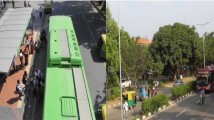Abstract
To determinate the expressway capacity near a bus bay stop with an access, capacity models on the expressway near a bus stop with an access were developed on the basis of gap acceptance theory and queuing theory. Depending on a bus stop position to an entrance or an exit ramp, the capacity models were developed for four cases. Bus bay stops with overflow and bus bay stops without overflow were considered. A comparison of simulation experiment and model calculation was carried out. Results show that the suggested models have high accuracy and reliability, at bus arrival rate below 60 vehicles per hour (veh/h) or vehicle volumes at the entrance and the exit below 200 passenger cars units per hour (pcu/h), and there are no significant difference in the capacities for four cases. When bus arrival rate is above 240 veh/h, the capacities of all four cases will decline rapidly. With berth number increasing, the increasing of the capacities is no obvious for four cases. As the bus arrival rate and vehicle volumes at the entrance and the exit increase, bus stops located downstream of an entrance and upstream of an exit have a remarkably effect on the capacities. The latter case is much heavier than the former. Those results can be used to traffic design and optimization on urban expressway near a bus stop with an access.
Similar content being viewed by others
References
KOSHY R Z, ARASAN V A. Influence of bus stops on flow characteristics of mixed traffic [J]. Journal of Transportation Engineering, 2005, 131(8): 640–643.
TANG Tie-qiao, LI Yan, HUANG Hai-jun. The effects of bus stop on traffic flow [J]. International Journal of Modern Physics C, 2009, 20(6): 941–952.
FEMANDEZ R. Modeling public transport stops by microscopic simulation [J]. Transportation Research Part C, 2010, 18(6): 856–868.
IBEAS A, DELL’OLIO L, ALONSOB SAINZ O. Optimizing bus stop spacing in urban areas[J]. Transportation Research Part E, 2010, 46(3): 446–458.
TAN Ji-yuan, LI Zhi-heng, LI Li, ZHANG Yi, LU Lu. Berth assignment planning for multi-line bus stops [J]. Journal of Advanced Transportation, 2014, 48(7): 750–765.
ZHAO Xiao-mei, GAO Zi-you, JIA Bin. The capacity drop caused by the combined effect of the intersection and the bus stop in a CAmodel [J]. Physica A, 2007, 385(2): 645–658.
GU Wei-hua, CASSIDY M J, GAYAH V V, OUYANG Yan-feng. Mitigating negative impacts of near-side bus stops on cars [J]. Transportation Research Part B, 2013, 47: 42–56.
GU Wei-hua, GAYAH V V, CASSIDY M J, SAADE N. On the impacts of bus stops near signalized intersections: Models of car and bus delays [J]. Transportation Research Part B, 2014, 68: 123–140.
YANG Xiao-bao, SI Bing-feng, HUAN Mei. Mixed traffic flow modeling near Chinese bus stops and its applications [J]. Journal of Central South University, 2012, 19(9): 2697–2704.
JIN Wen-long. Continuous kinematic wave models of merging traffic flow [J]. Transportation Research Part B, 2010, 44: 1084–1103.
JETTO K, EZ-ZAHRAOUVY H, BENYOUSSEF A. An investigation of merging and diverging cars on a multi-lane road using a cellular automation model [J]. Chinese Physics B, 2012, 21(11): 118901.
SPILIOPOULOU A, KONTORINAKI M, PAPAGEORGIOU M, KOPELIAS P. Macroscopic traffic flow model validation at congested freeway off-ramp areas [J]. Transportation Research Part C, 2014, 41: 18–29.
MARCZAK F, DAAMEN W, BUISSON C. Merging behavior: Empirical comparison between two sites and new theory development [J]. Transportation Research Part C, 2013, 36: 530–546.
POLLATSCHEK M A, POLUS A, LIVNEH M. A decision model for gap acceptance and capacity at intersections [J]. Transportation Research Part A, 2002, 36: 649–663.
REN Fu-tian, LIU Xiao-ming, RONG Jian. Traffic Engineering, Second edition [M]. Beijing: China Communication Press, 2008: 120–123. (in Chinese)
Ministry of Housing and Urban-Rural Development of the People’s Republic of China. Specification for design of urban expressway [M]. Beijing: China Architecture & Building Press, 2009: 4-5. (in Chinese)
Author information
Authors and Affiliations
Corresponding author
Additional information
Foundation item: Project(2012CB723303) supported by National Basic Research Program of China
Rights and permissions
About this article
Cite this article
Zhang, Hb., Sun, Xd., He, Yl. et al. Capacity models on expressway near a bus bay stop with an access. J. Cent. South Univ. 22, 3239–3246 (2015). https://doi.org/10.1007/s11771-015-2862-6
Received:
Accepted:
Published:
Issue Date:
DOI: https://doi.org/10.1007/s11771-015-2862-6




